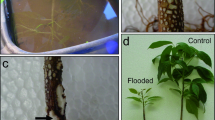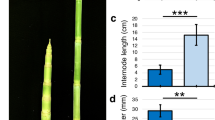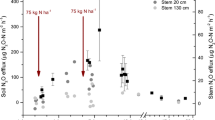Abstract
Ethanol synthesis was induced in stem segments from greenhouse-grown conifer seedlings by placing them in a N2 atmosphere at 30 °C for 24 h. Stems from ponderosa pine,Pinus ponderosa Dougl. ex Laws., sugar pine,Pinus lambertiana Dougl., Pacific silver fir,Abies amabalis Dougl. ex Forbes, and lodgepole pine,Pinus contorta Dougl. ex Loud, produced the highest quantities of ethanol. This group also had the smallest and slowest growing stems. Within each of these species the amount of ethanol produced was inversely related to the stem volume. Stems from western hemlock,Tsuga heterophylla (Raf.) Sarg., grand fir, Abies grandis Dougl. ex Forbes, Douglas-fir,Pseudotsuga menziesii (Mirb.) Franco, and western redcedar,Thuja plicata Donn ex D. Don, all produced equivalent but low ethanol concentrations. These species had the largest and fastest growing stems. In this group only grand fir exhibited an inverse relationship between ethanol concentrations and stem volume. The relative amounts of ethanol synthesized by stems from Douglas-fir, western hemlock and western redcedar seedlings were not the same as subsequently observed in logs from mature trees of the same species under field conditions. Differences in the anaerobic environments for the two stem types could have affected the quantities of ethanol produced. The observed high amounts of ethanol produced by the stems from pine species were discussed in terms of their ability to handle periods of anaerobic stress or hypoxia.
Similar content being viewed by others
References
Andreev VY, Vartapetian BB (1992) Induction of alcoholic and lactic fermentation in the early stages of anaerobic incubation of higher plants. Phytochemistry 31: 1859–1861
Bannan MW (1955) The vascular cambium and radial growth inThuja occidentalix L. Can J Bot 33: 113–138
Bannan MW (1962) The vascular cambium and tree-ring development. In: Kozlowski TT (ed) Tree growth. Ronald Press, New York, pp 3–21
Barnett JP, Naylor AW (1969) Alcohol dehydrogenase activity and ethanol utilization in germinating longleaf and slash pine seeds. For Sci 15: 400–403
Bennett DC, Freeling M (1987) Flooding and the anaerobic stress response. In: Newman DW, Wilson KG (eds) Models in plant physiology and biochemistry, vol III. CRC Press, Boca Raton, Florida, pp 79–84
Burns RM, Honkala BH (technical coordinators) (1990) Silvics of North America, vol 1, Conifers. Agric Handbook 271. US Dept Agric, For Serv, Washington DC
Cade SC, Hrutfiord BF, Gara RI (1970) Identification of a primary attractant forGnathotrichus sulcatus isolated from western hemlock logs. J Econ Entomol 63: 1014–1015
Chapman JA (1961) A note on felling date in relation to log attack by the ambrosiaTrypodendron. Can Dept For Bi-Mon Prog Rep 17: 3–4
Chung H-H, Barnes RL (1980) Phytosynthate allocation inPinus taeda. III. Photosynthate economy: its production, consumption and balance in shoots during the growing season. Can J For Res 10: 348–356
Conlin TSS, Lieffers VJ (1993) Anaerobic and aerobic CO2 efflux rates from boreal forest conifer roots at low temperatures. Can J For Res 23: 767–771
Coutts MP, Armstrong W (1976) Role of oxygen transport in the tolerance of trees to waterlogging. In: Cannell MGR, Last FT (eds) Tree physiology and yield improvement. Academic Press, London
Crawford RMM (1976) Tolerance of anoxia and the regulation of glycolysis in tree roots. In: Cannell MGR, Last FT (eds) Tree physiology and yield improvement. Academic Press, London, pp 387–401
Crawford RMM (1989) Studies in plant survival. Blackwell, Boston, pp 105–129
Crawford RMM, Baines MA (1977) Tolerance of anoxia and the metabolism of ethanol in tree roots. New Phytol 79: 519–526
Crawford RMM, Finegan DM (1989) Removal of ethanol from lodgepole pine roots. Tree Physiol 5: 53–61
Grillos SJ, Smith FH (1959) The secondary phloem of Douglas-fir. For Sci 4: 377–388
Harry DE, Kimmerer TW (1991) Molecular genetics and physiology of alcohol dehydrogenase in woody plants. For Ecol Manage 43: 251–272
Hook DD, Scholtens JR (1978) Adaptations and flood tolerance of tree species. In: Hook DD, Crawford RMM (eds) Plant life in anaerobic environments. Ann Arbor Science, Ann Arbor, Michigan, pp 299–311
Hunt FM (1951) Effects of flooded soil on growth of pine seedlings. Plant Physiol 26: 363–368
Jayasekera GAU, Reid DM, Yeung EC (1989) Fates of ethanol produced during flooding of sunflower roots. Can J Bot 68: 2408–2414
Johnson NE (1958) Ambrosia beetle infestation of coniferous logs on clearcuttings in northwestern Oregon. J For 56: 508–511
Joly CA, Crawford RMM (1982) Variation in tolerance and metabolic responses to flooding in some tropical trees. J Exp Bot 33: 799–809
Kelsey RG (1994a) Ethanol synthesis in Douglas-fir logs felled in November, January, and March and its relationship to ambrosia beetle attack. Can J For Res 24: 2096–2104
Kelsey RG (1994b) Ethanol and ambrosia beetles in Douglas-fir logs with and without branches. J Chem Ecol 20: 3307–3319
Kimmerer TW, MacDonald RC (1987) Acetaldehyde and ethanol biosynthesis in leaves of plants. Plant Physiol 84: 1204–1209
Kimmerer TW, Stringer MA (1988) Alcohol dehydrogenase and ethanol in the stems of trees. Plant Physiol 87: 693–697
Kozlowski TT (1984) Response of woody plants to flooding. In: Kozlowski TT (ed) Flooding and plant growth. Academic Press, Orlando, pp 129–163
Kramer PJ, Kozlowski TT (1979) Physiology of woody plants. Academic Press, San Diego
Krueger KW (1967) Nitrogen, phosphorus, and carbohydrate in expanding and year-old Douglas-fir shoots. For Sci 13: 352–356
Levan MA, Riha SJ (1986) Response of root systems of northern conifer transplants to flooding. Can J For Res 16: 42–46
MacDonald RC, Kimmerer TW (1991) Ethanol in the stems of trees. Physiol Plant 82: 582–588
MacDonald RC, Kimmerer TW (1993) Metabolism of transpired ethanol by eastern cottonwood (Populus deltoides Bartr.). Plant Physiol 102: 173–179
Minore D (1968) Effects of artificial flooding on seedling survival and growth of six northwestern tree species. USDA For Serv Res Note PNW-92
Minore D (1970) Seedling growth of eight northwestern tree species over three water tables. USDA For Serv Res Note PNW-115
Moeck HA (1970) Ethanol as the primary attractant for the ambrosia beetleTrypodendron lineatum (Coleoptera: Scolytidae). Can Entomol 102: 985–995
Ramsey F, Schafer D (1993) The statistical sleuth: an intermediate course in statistical methods. Unpublished manuscript, Oregon State University, Corvallis, p 177
Roberts JKM, Callis J, Wemmer D, Walbot V, Jardetzky O (1984) Mechanism of cytoplasmic pH regulation in hypoxic maize root tips and its role in survival under hypoxia. Proc Natl Acad Sci 81: 3379–3383
Roberts JKM, Andrade FH, Anderson IC (1985) Further evidence that cytoplasmic acidosis is a determinant of flooding intolerance in plants. Plant Physiol 77: 492–494
Smith AM, Kalsi G, Woolhouse HW (1984) Products of fermentation in the roots of alders (Alnus Mill.). Planta 160: 272–275
Walker LC, Green RL, Daniels JM (1961) Flooding and drainage effects on slash pine and loblolly pine seedlings. For Sci 7: 3–15
Webb WL (1975) Dynamics of photoassimilated carbon in Douglas fir seedlings. Plant Physiol 56: 455–459
Webb WL (1977) Seasonal allocation of phytoassimilated carbon in Douglas fir seedlings. Plant Physiol 60: 320–322
Wilson BF (1963) Increase in cell wall surface area during enlargement of cambial derivatives inAbies concolor. Am J Bot 50: 95–102
Xia J-H, Roberts JKM (1994) Improved cytoplasmic pH regulation, increased lactate efflux, and reduced cytoplasmic lactate levels are biochemical traits expressed in root tips of whole maize seedlings acclimated to a low-oxygen environment. Plant Physiol 105: 651–657
Zhong H, Schowalter TD (1989) Conifer bole utilization by woodboring beetles in western Oregon. Can J For Res 19: 943–947
Author information
Authors and Affiliations
Rights and permissions
About this article
Cite this article
Kelsey, R.G. Anaerobic induced ethanol synthesis in the stems of greenhouse-grown conifer seedlings. Trees 10, 183–188 (1996). https://doi.org/10.1007/BF02340770
Received:
Accepted:
Issue Date:
DOI: https://doi.org/10.1007/BF02340770




